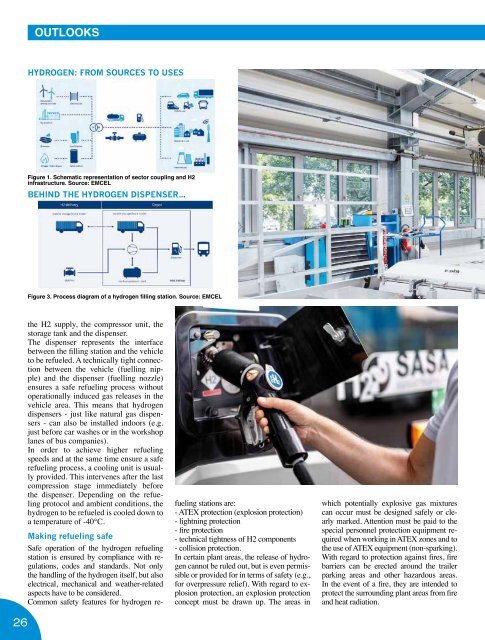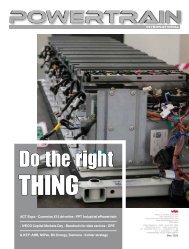SUSTAINABLE BUS 2-2023
Topics? A clear picture of fundings available for zero emission buses in UK, an insight on the fuel cell bus market, a glimpse of the largest electric bus fleet in Middle East (hint: Mowasalat). Again: focus on safety precautions in H2 bus depots, a commentary on the market for second hand e-buses (and battery residual value). Finally: technical presentations of VDL Citea new generation (cover story!), Iveco Bus Crossway LE CNG, Rampini Hydron (and new zero emission bus range)
Topics? A clear picture of fundings available for zero emission buses in UK, an insight on the fuel cell bus market, a glimpse of the largest electric bus fleet in Middle East (hint: Mowasalat). Again: focus on safety precautions in H2 bus depots, a commentary on the market for second hand e-buses (and battery residual value).
Finally: technical presentations of VDL Citea new generation (cover story!), Iveco Bus Crossway LE CNG, Rampini Hydron (and new zero emission bus range)
Create successful ePaper yourself
Turn your PDF publications into a flip-book with our unique Google optimized e-Paper software.
OUTLOOKS<br />
HYDROGEN: FROM SOURCES TO USES<br />
Figure 1. Schematic representation of sector coupling and H2<br />
infrastructure. Source: EMCEL<br />
BEHIND THE HYDROGEN DISPENSER…<br />
Handling hydrogen in<br />
enclosed spaces involves<br />
three basic rules. The<br />
first is that good ventilation<br />
must be provided<br />
in the rooms. Secondly,<br />
in general, sources of<br />
ignition should be avoided<br />
in rooms. Grounding<br />
of vehicles is a general<br />
requirement for refueling.<br />
Third and last, for indoor<br />
hydrogen applications,<br />
H2 sensors should be<br />
used. These measure<br />
the percentage hydrogen<br />
concentration in the air<br />
and warn when critical<br />
values are exceeded. At<br />
the same time, this activates<br />
safety measures.<br />
Figure 3. Process diagram of a hydrogen filling station. Source: EMCEL<br />
the H2 supply, the compressor unit, the<br />
storage tank and the dispenser.<br />
The dispenser represents the interface<br />
between the filling station and the vehicle<br />
to be refueled. A technically tight connection<br />
between the vehicle (fuelling nipple)<br />
and the dispenser (fuelling nozzle)<br />
ensures a safe refueling process without<br />
operationally induced gas releases in the<br />
vehicle area. This means that hydrogen<br />
dispensers - just like natural gas dispensers<br />
- can also be installed indoors (e.g.<br />
just before car washes or in the workshop<br />
lanes of bus companies).<br />
In order to achieve higher refueling<br />
speeds and at the same time ensure a safe<br />
refueling process, a cooling unit is usually<br />
provided. This intervenes after the last<br />
compression stage immediately before<br />
the dispenser. Depending on the refueling<br />
protocol and ambient conditions, the<br />
hydrogen to be refueled is cooled down to<br />
a temperature of -40°C.<br />
Making refueling safe<br />
Safe operation of the hydrogen refueling<br />
station is ensured by compliance with regulations,<br />
codes and standards. Not only<br />
the handling of the hydrogen itself, but also<br />
electrical, mechanical and weather-related<br />
aspects have to be considered.<br />
Common safety features for hydrogen re-<br />
fueling stations are:<br />
- ATEX protection (explosion protection)<br />
- lightning protection<br />
- fire protection<br />
- technical tightness of H2 components<br />
- collision protection.<br />
In certain plant areas, the release of hydrogen<br />
cannot be ruled out, but is even permissible<br />
or provided for in terms of safety (e.g.,<br />
for overpressure relief). With regard to explosion<br />
protection, an explosion protection<br />
concept must be drawn up. The areas in<br />
which potentially explosive gas mixtures<br />
can occur must be designed safely or clearly<br />
marked. Attention must be paid to the<br />
special personnel protection equipment required<br />
when working in ATEX zones and to<br />
the use of ATEX equipment (non-sparking).<br />
With regard to protection against fires, fire<br />
barriers can be erected around the trailer<br />
parking areas and other hazardous areas.<br />
In the event of a fire, they are intended to<br />
protect the surrounding plant areas from fire<br />
and heat radiation.<br />
H2 AND NATURAL GAS, SIMILARITIES AND DIFFERENCES<br />
Hydrogen H2 Methane CH4<br />
Lower and upper concentration limits for ignition 4 %...74 % 4,1 %…16,5 %<br />
Ignition temperature 560°C 575…640°C<br />
Minimum ignition energy 0,02 mJ 0,28 mJ<br />
Figure 2. Substance data of hydrogen in comparison with natural gas. Source: EMCEL<br />
With regard to the design and installation<br />
of the H2 components, it is important that<br />
pipelines, containers, valves and fittings<br />
are technically tight or permanently technically<br />
tight (The definition used in this<br />
article refers to the German TRGS 722 -<br />
Technical Rules for Hazardous Substances).<br />
In the case of permanently technically<br />
tight components, no gas releases are<br />
to be expected. In the case of components<br />
that are technically tight, gas releases can<br />
also (infrequently) occur. Here, redundant<br />
safety measures are applied if necessary<br />
(e.g.: regular inspection by leakage test<br />
procedures).<br />
Safe handling of hydrogen<br />
Handling hydrogen in enclosed spaces<br />
involves three basic rules. The first is<br />
that good ventilation must be provided in<br />
the rooms. Otherwise, hydrogen leakage<br />
could result in elevated concentrations in<br />
the enclosed spaces. Ventilation systems<br />
provide increased air exchange, which<br />
minimizes or eliminates the risk of flammable<br />
concentrations forming. Secondly,<br />
In general, sources of ignition should be<br />
avoided in rooms. This applies in particular<br />
to gas workplaces and ATEX zones.<br />
Here, for example, grounding of vehicles<br />
is a general requirement for refueling.<br />
This can take place either by means of<br />
a grounding clamp or through the fuel<br />
nozzle and the tank hose itself, if certain<br />
In order to achieve higher<br />
refueling speeds and<br />
ensure a safe refueling<br />
process, a cooling unit is<br />
usually provided. This intervenes<br />
after the last compression<br />
stage immediately<br />
before the dispenser. The<br />
hydrogen to be refueled is<br />
usually cooled down to a<br />
temperature of -40°C.<br />
limits for insulation resistance are taken<br />
into account. Alternatively, a conductive<br />
ground can ensure that equipotential<br />
bonding is established. Another example<br />
of avoiding ignition sources is the use of<br />
ATEX equipment, for example for emergency<br />
lighting. Third and last, for indoor<br />
hydrogen applications, H2 sensors should<br />
be used. These measure the percentage<br />
hydrogen concentration in the air and<br />
warn when critical values are exceeded.<br />
At the same time, this activates safety measures.<br />
Hydrogen, safety is possible<br />
Safe operation with hydrogen is already<br />
possible today in exactly the same way<br />
as for other fuels. The similarity to natural<br />
gas makes it easier to switch to this<br />
technology, as approaches and safety concepts<br />
can be easily transferred. H2 refueling<br />
stations can also be operated safely<br />
and reliably indoors, provided appropriate<br />
safety measures are applied. For the<br />
construction of a hydrogen filling station,<br />
it is advisable to draw up a safety concept<br />
tailored to the specific application. In this<br />
way, cost-effective implementations can<br />
be achieved in a targeted manner!<br />
Nicolò Queirazza, Lennart Heine<br />
(EMCEL GmbH)<br />
26<br />
27

















